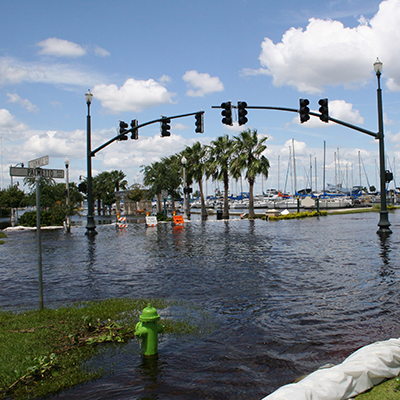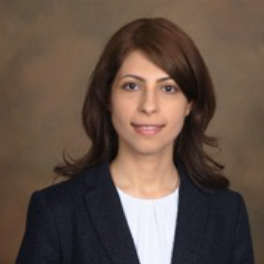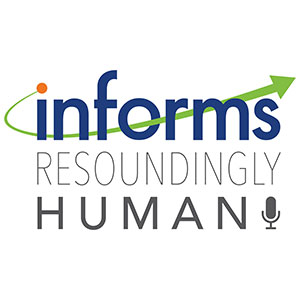Published: April 13, 2023

My guest for today’s interview is Shima Mohebbi, with the Department of Systems Engineering and Operations Research at George Mason University who recently completed a collaborative National Science Foundation (NSF)-funded study that explored how to improve community and infrastructure resiliency by better understanding and identifying the underlying dynamics and causal relationships to improve responses during disruptions, with a focus on mobility and public water resources.
We’ll be taking a look not only at her work, but sharing some insight on the experience of receiving (NSF) funding to support your research.
Recent tornadoes in Mississippi and numerous hurricanes, such as Irma and Harvey, are an example of service disruptions in critical infrastructure systems which affected thousands of people and marginalized communities.
Interviewed this episode:

Shima Mohebbi
George Mason University
Shima Mohebbi is an assistant professor in the Department of Systems Engineering and Operations Research, and affiliate faculty of Computer Science at George Mason University. Shima is also a core faculty of C-RASC (Center for Resilient and Sustainable Communities) at Mason. Her research interests include game theory, simulation, network optimization, and machine learning with applications in resilient infrastructure systems, sustainable water systems, and smart and connected communities. Shima has collaborated across disciplines including civil engineering, computer science, social science, and geoinformation science. She received her PhD in Industrial and Systems Engineering, and her second master’s degree in Statistics from the University of Tennessee. Her research is supported by the National Science Foundation and the U.S. Department of Transportation. Shima has served as a board director in the Modeling and Simulation Division of the Institute of Industrial and Systems Engineers for two terms, and is passionate about engineering education and outreach activities. In her spare time, Shima enjoys playing the piano and is an outdoor enthusiast.
Related Episodes
Episode Transcript
My guest for today’s interview is Shima Mohebbi with the Department of Systems Engineering and Operations Research at George Mason University, who recently completed a collaborative National Science Foundation, NSF funded study that explored how to improve community and infrastructure resiliency by better understanding and identifying the underlying dynamics and causal relationships to improve responses during disruptions with a focus on mobility and public water resources. We’ll be taking a look not only at her work, but sharing some insight on the experience of receiving NSF funding to support your research. Shima, thanks so much for joining me.
Shima Mohebbi:
Thank you Ashley for having me.
Ashley Kilgore:
So your study looks closely at infrastructure and organizational resilience. To set the stage for our conversation, could you share a little background on what that is referring to?
Shima Mohebbi:
Absolutely. There are 16 critical infrastructure sectors whose assets, systems and networks, whether cyber or physical are necessary for the functionality of cities, national security and public health. Communications, healthcare and public health, energy, transportation, and water and wastewater systems are among those sectors just to name a few. These infrastructure systems are not isolated, but interconnected at different levels and embedded inside of social systems. It includes cultural values in communities and organizational arrangements in utilities. The standard functionality of such interconnected sociotechnical systems can be jeopardized by external stressors such as extreme weather events, human related activities, and population growth. Therefore, in any community, we need to have the capacity to better cope with extreme events and infrastructure breakdowns due to aging and quickly recover from them and learn and adapt to future similar disruptions. This is referred to as infrastructure and organizational resilience.
Ashley Kilgore:
I’d love to take a look at what inspired this research. Essentially, how did the idea come together? Was it based on previous insight?
Shima Mohebbi:
Well, over the past decades, each infrastructure sector has become more integrated, advocates resource sharing, and operational research interventions to improve the performance measures. However, cascading failure is a common aftermath in interconnected systems when a disruptive event occurs. For example, a water main birth in the city of Tampa, Florida back in 2017 caused road closure for around one week and affected about 20,000 commuters for one week. Therefore, it’s important to study collective performance, focus on interdependencies among infrastructure sectors, and understand the collective behavior of stakeholders at community and municipal levels. Essentially, the question was, given the physical, financial, and informational constraints, how do stakeholders from different organizations work together to respond to service disruptions, which are stochastic in nature? This interdisciplinary and challenging research question encourage collaboration among different engineering and social science disciplines.
Ashley Kilgore:
So your research team members come from universities across the country. How did you all connect to work on this research?
Shima Mohebbi:
That’s a great question. My training is in industrial and systems engineering and statistics. For my postdoc, I joined a civil and environmental engineering department. This produced a synergy that resulted in expanding the network of my collaborators and learning more about infrastructure systems and their social aspects. This also encouraged me to attend conferences organized by other professional societies such as ASCE, American Society of Civil Engineers and the Society of Risk Analysis, and I could connect with more researchers from other schools and national labs working in similar areas.
Ashley Kilgore:
Now, what was the basis in your research for focusing on mobility and water infrastructures in Tampa, Florida specifically?
Shima Mohebbi:
Tampa is a mid-size coastal city with nearly a population of 400,000. The city is prone to different natural hazards such as hurricanes and floods, and has extensive yet aging infrastructure in place for roadways and water. Currently, water and road infrastructures are managed and regulated by separate agencies. As a result, the institutions overseeing these infrastructures are organized differently in terms of decision making, which creates both opportunities and challenges for critical infrastructure management. This made Tampa an ideal test bit for our study. In addition, the interface of water as an underground infrastructure and surface transportation was not explored in the literature as deep as other sectors such as energy and transportation. That was another motivation to focus on cyber physical and social interdependencies in these two infrastructure systems.
Ashley Kilgore:
So now I’d love to have you share a very sort of high level summary of how your research was conducted.
Shima Mohebbi:
Yeah, absolutely. This research was conducted in collaboration with my colleagues from the anthropology and civil and environmental engineering departments at the University of South Florida. Prior to model development, our social science collaborator conducted in-depth semi-structured interviews with representatives from the water and mobility departments to obtain multiple perspectives on infrastructure interdependencies and interdepartmental coordination. To take it further and better understand how practitioners in the fields of water and transportation management understand and experience organizational resilience and the ways and extend to which they perceive of infrastructure interdependencies, we designed a comprehensive sociotechnical survey and distributed online across the US.
Overall, a total of 12 US estates were represented in our sample. The interviews and surveys results significantly informed the structure and parameters of our simulation and optimization models, and we identify the dynamics and causal relationships between the physical, financial, and informational layers under both normal and extreme events conditions. We verified our models by comparing simulated output to the historical data. We then identified and evaluated several strategies for enhancing infrastructure and organizational resilience while communication and coordination schemes were taken into account. We also had annual meetings with utilities and their administrators in the city of Tampa throughout the project to receive their feedback and communicate our research output.
Ashley Kilgore:
What, if any, were some of the challenges that you encountered in your research?
Shima Mohebbi:
Well, I would say developing CDS scale optimization and simulation models was the most challenging part for my research team. This motivated us to focus on the scalability of solution algorithms for optimization models, as well as the computational efficiency of simulation models. We also worked closely with our civil engineering collaborators to make reasonable assumptions in our decision making models.
Ashley Kilgore:
And now ultimately, what was the outcome of your work? What valuable insight did you gain?
Shima Mohebbi:
In this research, we demonstrated that in addition to cyber physical systems, the organizational characteristic of each infrastructure sector such as finance, communication structures and situational awareness need to be understood and integrated into decisions which support the resilience of infrastructure systems and communities. In particular, we found that the learning strategy, which reinforced proactive maintenance policy generates the most effective outcomes. This highlights how organizations can learn from past successes and failures to effectively manage critical infrastructures. We also conducted a trade-off analysis to provide insight on the fortification and restoration decisions at the municipal level.
Ashley Kilgore:
Now, while your research was focused on water and transportation infrastructures, are there other municipal applications that your insight could be applied to?
Shima Mohebbi:
Excellent question. Yes. Our framework for capturing interdependencies and allocating scarce resources before, during, and after disruptive events can be applied to other sectors such as energy and manufacturing with proper model and parameter adjustments.
Ashley Kilgore:
Shima, I’d love to switch gears and talk about your National Science Foundation funding. Can you share a bit about what the process in the experience was like receiving funding from the NSF?
Shima Mohebbi:
Well, this project was my first collaborative grant from NSF. The first step was to find a solicitation and put together the initial idea and research team. I was fortunate enough to be part of a multidisciplinary team from engineering and social science disciplines. We prepared the project summary and scheduled a meeting with the program director. We received some high level suggestions, and I found them useful for writing the proposal. Connecting with public utilities and getting them on board to support our research effort with data and feedback was another critical step in this process. We also try to explain our approach for verification and validation in the proposal. Eventually, the status of the proposal changed to recommended, and it was a very exciting moment for me.
Ashley Kilgore:
So to someone who is considering applying for NSF funding, what’s the best advice you could offer them?
Shima Mohebbi:
First, I would suggest reviewing the recent awards and the program of interest. This will give a very good idea of what topics have recent we’ve been funded. If the proposal is going to be collaborative, it’s critical to find the right collaborators with the required skillset for the proposed project. My final advice is to be open to revising the proposal and idea based on the NSF panel comments. While there might be variations in individual reviews, I always find the panel summary useful.
Ashley Kilgore:
Shima, thank you again so much for joining me today to talk about your work. Before we wrap up, I’d love to have you share how you feel working on this study might impact your future research.
Shima Mohebbi:
Well, I learned a lot from this research project. I realized that working with a multidisciplinary team is challenging, inspiring, and rewarding at the same time. This experience also reinforced my passion for developing novel operations research and systems thinking approaches to tackle grant engineering challenges and weak problems. At the end, I would like to take this opportunity to thank my collaborators and fantastic graduate students. This work wouldn’t have been possible without their dedication and efforts.
Ashley Kilgore:
Want to learn more? Visit resoundinglyhuman.com for additional information on this week’s episode and guest. The podcast is also available for download or streaming from Apple Podcasts, Google Play, Stitcher, and Spotify. Wherever you listen, if you enjoy Resoundingly Human, please be sure to leave a review to help spread the word about the podcast. Until next time, I’m Ashley Kilgore and this is Resoundingly Human.
Want to learn more? Check out the additional resources and links listed below for more information about what was discussed in the episode.
Web: https://mohebbilab.cec.gmu.edu/
Twitter: https://twitter.com/shimamohebbi


